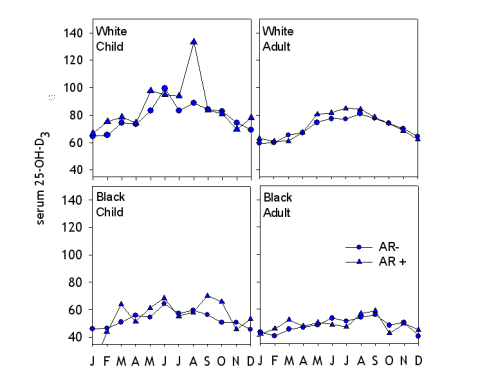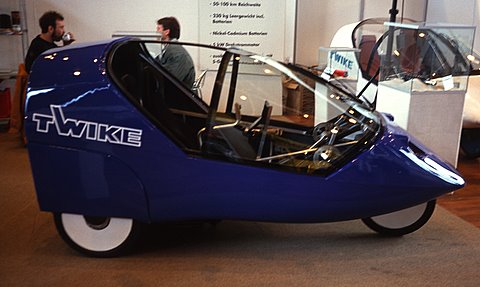Here is the announcement of an allergy meeting in London (where I will be too :-). Continue reading Allergy School
Tag Archives: Asthma + Allergy
Another path from vitamin D to allergy
As far as I know vitamin D3 influences only RUNX2 expression (RUNX2 has a VDRE, possibly also RUNX3 but not RUNX1?). The RUNX factors
colocalized in common subnuclear foci. Furthermore, RUNX subnuclear foci contain the co-regulatory protein CBFβ, which heterodimerizes with RUNX factors, and nascent transcripts as shown by BrUTP incorporation. These results suggest that RUNX subnuclear foci may represent sites of transcription containing multi-subunit transcription factor complexes.
Variants in RUNX1 have already been reported earlier to be weakly associated with IgE serum levels in Korea.
A Nature paper todays reports that Foxp3 controls Treg function by interacting with AML1/RUNX1 – is there any connecting path?
Higher metabolic rate or better signalling
In a forthcoming paper in Allergy (scienceblog:doi:10.1111/j.1398-9995.2007.01437.x:) we will show an association of vitamin D (25-OH-D3) serum levels and allergic rhinitis (AR) mainly in white Caucasians. Here is a supplemental figure that shows the seasonal variation in AR+ and AR- individuals.
Except of the singular peak in white children, I can´t see so much difference – so probably the vitamin D signalling pathway is different in AR.
Figure: Month of examination in allergic rhinitis patients of NHANES III by age age and ethnic background – no clear effects by higher metabolism.
Allergy research 1900-1933
Here is a brief summary of allergy research as an index to Schadewaldt
1900 Posselt (1:370; 4:44)
enteritis membranacea used synonymous to asthma
1902 Kratschmer (2:100)
hay fever is triggered by trigeminus reflex Continue reading Allergy research 1900-1933
Climate change
There is no need for another diagnosis here. There is also no need about the impact of the automobile industry – I have published in 1993 the first large epidemiological study about traffic and respiratory health here in Munich.
What could we do? People need to move but need alternatives to public transport or 1000kg cars.
One such alternative is being the Swiss made twike Twike that I could get for a ride – excellent driving experience (quite fast too!) while needing only 0.5 l equivalent per 100 km. Although I am also attracted by recumbents and gyrocopters, this seems to be the best alternative ;-)
Lymphopoetin and allergy
This is to convince me that the thymic stromal lymphopoietin (TSLP) is a master switch in allergy
Skin-specific overexpression of TSLP resulted in an AD-like phenotype, with the development of eczematous lesions containing inflammatory dermal cellular infiltrates, a dramatic increase in Th2 CD4+ T cells expressing cutaneous homing receptors, and elevated serum levels of IgE.
Topical application of the physiologically active ligand [1{alpha},25-(OH)2D3; calcitriol] of the vitamin D receptor, or of its low-calcemic analog MC903 (calcipotriol; Dovonex), induces TSLP expression in epidermal keratinocytes, which results in an atopic dermatitis-like syndrome.
TSLP, synergistically with interleukin 1 and tumor necrosis factor, stimulates the production of high levels of Th2 cytokines by human mast cells (MCs) … TSLP is released by primary epithelial cells in response to certain microbial products, physical injury, or inflammatory cytokines.
Proinflammatory TNFalpha or IL-1alpha and Th2 (IL-4 or IL-13) cytokines synergized to induce the production of TSLP in human skin explants … Our data provide the first evidence of TSLP induction and subsequent DC activation in human skin.
Mice with an IEC[intestinal epithelial cell]-specific deletion of IKKbeta show a reduced expression of the epithelial-cell-restricted cytokine thymic stromal lymphopoietin in the intestine and, after infection with the gut-dwelling parasite Trichuris, fail to develop a pathogen-specific CD4+ T helper type 2 (TH2) response and are unable to eradicate infection. Further, these animals show exacerbated production of dendritic-cell-derived interleukin-12/23p40.
… (TSLP) and interleukin-7 share a common receptor chain, IL-7Rα … The gene encoding the IL-7Rα chain is polymorphic, and investigation of inhalation allergic patients compared with controls showed significant association with two alleles at position +1237 and +2087.
… TSLP represents a master switch of allergic inflammation at the epithelial cell and dendritic cell interface.
Para alergia
Seen summer 1990 in a small village close to Bilbao.
Notes on asthma in Africa
I have just found our most recent PLOS paper about asthma in Africa being published online
As of the 1980s, there was an overall conviction that asthma had an anthropogenic origin with indoor and outdoor air pollution as the main culprits. Following some overinterpreted epidemiological findings of the “hygienic†phase, there is now evidence accumulating that the asthma epidemic might have an iatrogenic origin. There might not only be indirect effects of improved living standards and better medical care, there are even direct effects under discussion, for example by oestrogens, vitamin D, antibiotics, and paracetamol. Infant formula (which contains vitamin D) has already entered the food chain in Africa; paracetamol is the most common drug bought over the counter in Ghana. Do African countries offer any unique observations where singular effects of these drugs can be delineated?
An independent review (that I did not know at time of writing) arrived at similar conclusions. We all, however, forgot to mention sensational news as Gambian president Yahya Jammeh can heal asthma click – click – a more serious appraisal click.
Dual vitamin D effects on type 1 diabetes and allergy
Early vitamin D supplementation may have dual effects, protecting against type 1 diabetes and inducing allergy. Is that possible? Yes, individual genes variants may determine the outcome.
In addition to HLA the most prominent type 1 diabetes genes are INS – CTLA4 – PTPN22 – CD25 – IF1H1, the most prominent asthma/allergy genes ADAM33 – DPP10 – IL12 – IL4 – GPR154 – FLG. I can´t see any joint master regulator, however, we know that
- CD25 is the IL2R
- and just learned from an excellent new mouse study that IL2 gene variation impairs regulatory T cell function
- while IL2 variants are associated with allergy
- IL2 is suppressed by vitamin D – known since 1985
Could that be a model to explain the dual involvement of vitamin D in both diseases?
Broken feedback loops
Salamander Candy has an interesting essay about Sir Karl Popper’s demarcation of science
The most informative and useful delineation between those pursuits understood as scientific, such as astronomy, and those of the pseudo-sciences, such as astrology, is that science integrates positive and negative feedback loops. These feedback loops are based on critical analysis, empirical testing, and reformulation of falsifiable statements. This process serves to maximize the accumulation of accurate statements and minimize the accumulation of erroneous statements within an integrated system of statements which describe the physical universe. In other words, the primary function of science, and the thing that makes it different from pseudo-science, is constructive self-criticism. Karl Popper, in his essay “Science: Conjectures and Refutations†(1963), claims that, “…the criterion of the scientific status of a theory is its falsifiability, or refutability, or testability.â€
This is a really nice account on the scientific theory that get nowadays more and more corrupted in daily practice (at least in biomedical research). For example there are currently 30-50 allergy research papers every day; many of these miss recent and important papers. Correct me if I am wrong but most biomedical research is accumulating only facts but not knowledge. The discussion section of many papers follow the boring outline — we found- — others found — some strengths and weaknesses of our research — some strengths and weaknesses of other research — further research required what I consider broken feedback loops. In my experience only half of the authors will respond to email enquiries regarding their articles.
It was therefore a real pleasure to see a new study on antibiotics and allergy with a true discussion wieghting pro and con arguments that was more worth than a meta-analysis on the same topic.
Something in the air
New studies further question the hygiene hypothesis of allergy induction. One study shows that a household bacterial elimination strategy does not lead to more — it even leads to less asthma.
Children living in a house regularly cleaned with bleach were less likely to have asthma (OR, 0.10; CI, 0.02-0.51), eczema (OR, 0.22; CI, 0.06-0.79) and of being sensitized to indoor aeroallergens (OR, 0.53; CI, 0.27-1.02)
Another study, by designing a 16S rRNA chip, examined a snapshot of urban air in San Antonio — the aerosol harbored at least 1,800 diverse bacterial types
a richness approaching that of some soil bacterial communities
You probably know the joke that before taking a deep breath think where the air has been before…
Addendum
The ecology of human skin has now been also reported – highly diverse, well conserved but low-level interpersonal consensus: scienceblog:doi:10.1073/pnas.0607077104
Say no
German Ärzteblatt has some important suggestions “Mehr Mut zum Nein-sagen” how the German healthcare system may be improved. In brief,
(1) patients need to be empowered to make their own health decision – Norwegians have on average only 3 but Germans 16 physician contacs per year
(2) during professional contact patients need more trust in doctor, nurse, pharmacist and physical therapist
(3) more money for the ill, less for the health people
Asthma – a disease of the gut
When starting in the asthma field in 1989, the textbooks told me that asthma is a disease of the lung. Some years later, asthma turned out to be a disease of the bone marrow cells. More recently, I raised the question if asthma could be even a disease of the gut – our largest immunological organ being frequently exposed to allergen & plenty of immunological active substances. Although on the different track (vitamin A) also other authors now think of an early impaired immune gut response.
Rather unexpected for me was a study in J Steroid Biochem Mol Biol that 1,25(OH)2D3 inhibits in vitro and in vivo intracellular growth of the parasite Toxoplasma gondii. yea, yea.
Genes wanted
The NIH and Jackson ask for nominations of their gene targeting approach (see also A mouse for All Reasons and my previous comment on the 3 R)
KOMP is a trans-NIH initiative to generate a public resource of mouse embryonic stem (ES) cells containing a null mutation in every gene in the mouse genome. Both conditional and null knockouts are being generated. The purpose of this form is to gather input from the scientific community on which genes should have the highest priority for being knocked out.
The Cell paper also explains the hard to understand differences in knockouts
- targeted deletion
- targeted conditional
- trapped conditional
although I still have semantic problems to understand the nomenclature. Anyway my whishlist – you can do me a favor by voting for CYP27B1, VDR, CYP24A1, OPN, IL4, IL5, IL10, IL12, IL13, FLG, CCR5 and CCR9.
Addendum
You can also leave some input at the Environmental Genome Project.
Let vitamin D shine in
said the Denver Post giving a nice overview of vitamin D research. This was just 1 day too early for a fascinating nature immunology paper (scienceblog:doi:10.1038/ni1433:) that links for the first time natural sunlight induced vitamin D action on dendritic cells. Seems that D3 will influence homing of T cells – we are again at “Licht und Leben“, yea, yea.
Addendum
- Don´t miss the nice talk by Dr. Vieth at insinc
- D3 induced Th1 block will allow Th17 action that is credited for causing and sustaining tissue damage
- D3 induces cathelicidin in another study.
- Deutschlandradio reported the vitamin D – allergy story on Feb 10, 2007.



